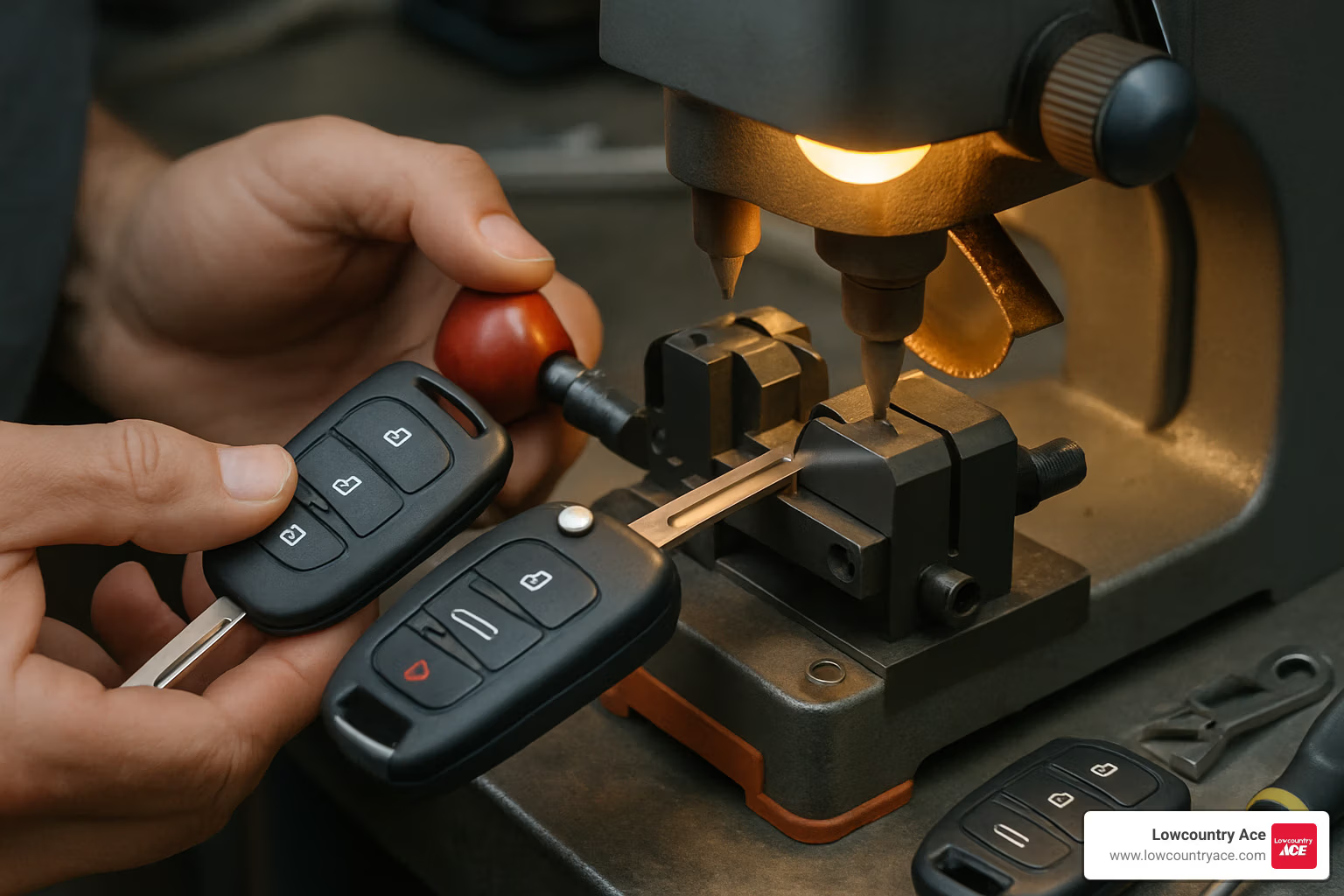DIY Car Key Cutting: 7 Powerful Tips for Easy Success 2025
Why DIY Car Key Cutting Could Save You Hundreds
DIY car key cutting is possible for basic mechanical keys, but comes with important limitations and risks. Here’s what you need to know:
Can You Cut Car Keys at Home?
– Basic keys: Yes, with proper tools and patience
– Transponder keys: Cutting possible, but programming requires special equipment
– Smart keys: Not recommended for DIY
– Cost savings: $80-$180 DIY vs $285-$500 professional
What You’ll Need:
– Compatible key blank ($3-$10)
– Key duplicating machine or hand files
– Safety equipment
– Programming device (for chip keys)
If you’re running late for work, the last thing you need is a missing car key. Modern car key replacement at dealerships can cost $285-$500 per key, while DIY solutions can reduce costs to as low as $80-$180 per key according to industry data.
But here’s the catch: DIY car key cutting works great for traditional metal keys, but gets tricky fast with modern transponder and smart keys. You’ll need specialized programming equipment, and one mistake could damage your car’s ignition system.
The helpful team at Lowcountry Ace has guided countless Charleston area homeowners through DIY projects, and we’ve seen how DIY car key cutting can save money when done right – but also the costly mistakes when safety steps are skipped.
Understand Your Car Key Before You Cut
Think of car keys like snowflakes – no two types are quite the same, and each one needs its own special approach for DIY car key cutting. Jump in with the wrong method, and you might end up with an expensive piece of metal that won’t even open your glove compartment.
Traditional keys are the friendly old-timers of the car key world. These simple metal keys work purely through mechanical cuts that line up with your lock’s pins. No fancy electronics, no complicated programming.
Transponder keys look innocent enough – they seem just like traditional keys but with a chunky plastic head. That plastic houses a tiny microchip that needs to have a conversation with your car’s computer system before it’ll let you start the engine.
Remote fob keys are the multitaskers – they combine a regular key blade with buttons for keyless entry. These need both the mechanical cutting done right and the electronic programming to sync up with your vehicle’s receiver.
Laser-cut keys (sometimes called sidewinder keys) are the tough guys with thicker metal and fewer grooves. They require specialized laser equipment that most home workshops don’t have sitting around.
Smart keys are the overachievers of the key family. They handle push-button start systems and advanced keyless entry through sophisticated programming protocols. Honestly, these are best left to the professionals.
Why Key Type Matters for DIY Car Key Cutting
Figuring out your key type determines whether DIY car key cutting makes sense for your situation or if you’re better off heading to a professional.
Chip identification starts with looking at that plastic head on your key. If it’s thick and chunky, there’s likely a transponder chip hiding inside.
Blade profile examination tells you a lot about what you’re dealing with. Traditional keys have those familiar cuts along both edges, just like a house key. Laser-cut keys show off with a single wavy cut running down the center of a thicker blade.
Is It Legal to Copy Your Own Key?
Here’s some good news – copying keys you actually own is perfectly legal. Your keys, your rules. Ownership proof is usually assumed when you walk in with the original key, though some locksmiths might ask to see your vehicle registration just to be safe.
Local regulations don’t typically restrict personal key duplication, but having a copied key doesn’t give you the right to use it on locks you don’t own.
Restricted & High-Security Keys
Some keys come with special restrictions that make them trickier to duplicate. These patent-protected keys often carry “Do Not Duplicate” warnings or special security markings for good reason.
Legal penalties for unauthorized duplication of restricted keys can reach up to $10,000 in fines under U.S. patent law.
| Key Type | DIY Difficulty | Legal Restrictions | Cost Range |
|---|---|---|---|
| Traditional | Easy | None | $5-15 |
| Transponder | Moderate | None | $25-80 |
| High-Security | Very Hard | Patent Protected | $50-150 |
| Smart Key | Nearly Impossible | Manufacturer Restricted | $200-500 |
Must-Have Tools & Materials for DIY Success
Getting into DIY car key cutting is like any good project – success depends on having the right tools from the start. The helpful team at Lowcountry Ace has seen plenty of Charleston area folks try to wing it with whatever they had lying around, and it rarely ends well.
Your foundation starts with key blanks, which run between $3.50 and $10.95 depending on your car’s make and model. Don’t be tempted to grab the cheapest option – quality blanks cut cleaner and last longer.
For the actual cutting, you’ll need a duplicator machine. Basic hand-operated models cost around $60-120 and work fine for occasional use. Semi-automatic units run $655-1,600, but unless you’re planning to start a side business, stick with the manual version.
Metal files are your best friends for fine-tuning. You’ll want both coarse and fine grades, plus some small needle files for getting into those tricky valleys. Calipers ensure your measurements are spot-on – key cutting tolerances are typically within 0.003 inches.
A solid bench vise keeps everything steady while you work, which is crucial for both safety and accuracy. Safety goggles aren’t optional – metal filings can cause serious eye injuries.
If you’re tackling transponder keys, you’ll need an OBD-II programmer. Handheld units start around $200, while software-based systems require a laptop and adapter cables. Don’t forget fresh batteries for key fobs.
For those in the Charleston area who want to split the difference, our Ace Hardware Key Cutting Machine service can handle the cutting while you focus on the programming part.
Shopping for Compatible Blanks
Finding the right blank makes or breaks your DIY car key cutting project. It’s not as simple as grabbing any blank that looks similar – precision matters here.
Start with a model/year lookup to ensure compatibility. The same car model can use completely different key blanks across different years, so always verify with your specific year.
The blade groove match must be exact. Even tiny differences in groove width or depth will leave you with a key that won’t turn.
For transponder keys, the chip ID must match your car’s immobilizer system. This information is usually tucked away in your owner’s manual or available from the dealer.
Our Car Key Replacement Ace Hardware guide breaks down compatibility information for popular vehicle makes.
Budget Breakdown: DIY Toolkit vs Dealer Fees
Let’s talk real money – because that’s probably why you’re considering DIY in the first place.
Your DIY toolkit investment breaks down like this: key blanks cost $3-10 each, a hand duplicator runs $60-120, files and tools add another $20-40, safety equipment costs $15-25, and a programming device (if needed) runs $200-400. Your total initial investment lands between $300-600.
Compare that to professional service costs: basic key cutting runs $5-15, transponder programming costs $80-180, locksmith service averages around $285 per key, and dealer replacement hits $285-500 per key.
The math works in your favor if you need more than 2-3 keys over time. But here’s the catch – this assumes you don’t make expensive mistakes that require professional repair.
Step-by-Step DIY Car Key Cutting
Here’s where the rubber meets the road – actually cutting your key. DIY car key cutting isn’t rocket science, but it does require a steady hand and plenty of patience. Think of it like learning to ride a bike: intimidating at first, but totally doable once you get the hang of it.
The helpful team at Lowcountry Ace has seen plenty of DIY projects over the years, and we know that success comes down to preparation and taking your time. Rush the job, and you’ll end up with an expensive piece of scrap metal.
DIY Car Key Cutting for Basic Mechanical Keys
Traditional keys are your best bet for learning DIY car key cutting. No fancy electronics to worry about – just good old-fashioned metalwork.
Start by securing both keys in your vise with perfect alignment. This is absolutely critical. Even being off by a hair will give you a key that doesn’t work. Use those soft jaw covers to protect your original key from scratches – you’ll need it as your reference throughout the process.
Filing the peaks first gives you solid reference points for everything else. These are the highest points on your original key, and they’re easier to match than the deep valleys. Use smooth, even strokes with your file, and check your progress every few passes. It’s like whittling – you can always take more off, but you can’t put it back.
The valley depths require more finesse. These deep cuts need to match exactly, or your key won’t push the lock pins to the right positions. A small needle file or even a Dremel tool makes this step much easier, though plenty of folks get by with just hand files and elbow grease.
Testing is everything. Slip your new key into the lock gently – never force it. Compare how it feels against the original. If it binds or feels rough, you’ve got more filing to do. The whole process typically takes 30 to 60 minutes for your first attempt, so don’t expect to rush through it.
DIY Car Key Cutting Challenges with Transponder Keys
Transponder keys throw a curveball into DIY car key cutting because you’re dealing with both the physical key and that little computer chip hiding in the plastic head.
The chip transplant method involves carefully taking apart your damaged original key and moving the chip to your newly cut blank. This requires patience and a steady hand – those chips are tiny and the antenna wires are fragile.
Some DIYers prefer the shell swap technique, where you cut a perfect metal blade and then swap it into your original key’s plastic housing. This keeps the original chip and all its programming intact, which can save you headaches later.
Watch out for epoxy risks if you’re gluing anything back together. Some adhesives can interfere with the chip’s radio signals, turning your perfectly cut key into a dud. Stick to electronics-safe adhesives, or better yet, use mechanical fasteners when possible.
Fine-Tuning and Smoothing the Cut
A roughly cut key might work once or twice, but it’ll wear out your lock and probably break at the worst possible moment. Taking time to finish it properly is worth every minute.
Sandpaper polishing with progressively finer grits – start with 220, then 400, then 800 – smooths out those rough file marks. Your lock’s pins will thank you, and the key will last much longer.
Graphite lubrication is an old locksmith trick. Just rub some pencil lead on the key teeth. It acts as a dry lubricant and actually helps you spot binding points when you test the key.
The feel test is your final exam. Your finished key should slide into the lock as smoothly as the original and turn with the same effort. Any sticking or grinding means you’ve got more work to do.
If all this sounds like more work than you bargained for, our Ace Hardware Auto Key Cutting Cost guide shows what professional service costs – sometimes the peace of mind is worth it.
Programming & Testing: Make the Key Talk to Your Car
Cutting the key is only half the battle with modern vehicles. The electronic programming step is where many DIY attempts fail, but it’s absolutely critical for transponder and remote keys.
Quick Programming Methods at Home
Many vehicles have on-board programming sequences that don’t require special equipment. These typically involve a series of key-on, key-off cycles within specific time windows. Your owner’s manual should detail this process if it’s available for your vehicle.
Door-lock cycling is another common method – you might need to lock and open up doors with the original key while holding buttons on the new fob. Timing is critical, and you usually only get a few attempts before the system locks you out temporarily.
Handheld programmers like the EZ Installer tool can handle many common vehicles. These cost $200-400 but work with multiple car makes, making them worthwhile if you plan to program several keys.
One forum user shared their experience: “I bought two blank FOBs on eBay and had them programmed locally for $80 each plus $10 for key cutting. Total cost was $180 versus ~$500 at the dealer and ~$285 from a locksmith.”
Troubleshooting a Non-Starting DIY Key
When your freshly cut key doesn’t start the car, don’t panic. Here are the most common issues:
Battery Check: Even new key fob batteries can be defective. Try a fresh battery from a different package before assuming programming failed.
Antenna Ring Fault: The antenna ring around your ignition switch must be working properly to read the transponder chip. A loose connection here will prevent any key from working.
Adapter Fit: If you’re using a programming device, ensure all connections are secure. One user reported success only after reseating a loose adapter cable that initially prevented programming.
Re-sync Requirements: Some vehicles need the immobilizer system reset after failed programming attempts. This might require a dealer visit or professional diagnostic equipment.
Best Practices for Smooth Operation
Once your key is cut and programmed, test it thoroughly:
Door & Ignition Test: Try all functions – door locks, trunk release, remote start (if equipped), and ignition operation. Test both locking and open uping from various distances.
Road Test: Take a short drive to ensure the key works reliably. Some immobilizer systems can be finicky and might work initially but fail after the engine warms up.
Spare Storage: Keep your DIY key in a different location from your primary keys. There’s no point having a spare if they’re lost together.
For professional programming services, visit our Ace Hardware Program Keys page for current pricing and availability.
DIY vs Professional: Weighing Cost, Convenience & Risk
Here’s where we need to have an honest conversation about DIY car key cutting. Yes, the savings look amazing on paper, but there are some real risks that could turn your money-saving project into an expensive headache.
The helpful team at Lowcountry Ace has seen plenty of DIY success stories, but we’ve also helped folks who got in over their heads. Understanding when to tackle a project yourself and when to call in the pros can save you both money and frustration.
Professional locksmiths bring years of experience and specialized equipment to the table. Hardware store kiosks offer a middle ground – professional equipment with lower costs than full locksmith services.
The risk of lock damage from a poorly cut key is real. Force a bad key into your ignition, and you might face costly repairs that dwarf any savings from DIY cutting.
When to Skip DIY and Call a Pro
Smart keys are definitely not DIY territory. These sophisticated systems use advanced encryption that requires dealer-level programming equipment.
If you’ve lost all keys, DIY becomes much harder. Most programming procedures need at least one working key to add new ones to the system.
High-security blades like laser-cut keys need precision cutting equipment that costs thousands of dollars. The tolerances are so tight that even experienced DIYers struggle with these.
Time pressure situations call for professional help too. If you’re stranded and need a working key right now, DIY isn’t practical. Our Key Cutter Near Me guide can help you find quick local service when you’re in a bind.
Money You Can Save (and Lose)
Let’s talk real numbers. DIY costs typically run $80-180 per key after you’ve invested in the initial tools. Locksmith services average around $285 per key, while dealer replacement can hit $500 per key or more.
Those savings look tempting until you consider what can go wrong. Lock damage from forcing a poorly cut key can require ignition cylinder replacement – we’re talking $1,000 or more in repair costs.
Common Mistakes First-Timers Make
We’ve seen these errors more times than we can count in the Charleston area. Wrong blank selection tops the list – choosing a key that looks similar but has different specifications for your exact vehicle year and model.
Over-filing is another costly mistake. Once you’ve removed too much material from the key cuts, there’s no going back.
Skipped programming leaves many DIYers scratching their heads when their perfectly cut transponder key won’t start the engine.
Ignoring safety gear might seem like a minor oversight, but metal filings in your eyes or cuts from sharp edges can turn a simple project into a medical emergency.
Frequently Asked Questions about DIY Car Key Cutting
Can I cut a laser-cut or sidewinder key at home?
Unfortunately, laser-cut keys are where DIY dreams hit reality. These thick, sturdy keys with their distinctive wavy cuts down the center require specialized laser equipment that costs several thousand dollars – way beyond what makes sense for home use.
The precision needed for laser-cut keys is incredible. We’re talking about cuts that must be accurate within thousandths of an inch, plus these keys typically have built-in transponder chips that add another layer of complexity. Your hand files and basic duplicator just can’t achieve this level of accuracy.
If you’ve got a laser-cut key (also called a sidewinder key), you’re better off heading to a professional. The helpful team at Lowcountry Ace has seen too many Charleston area folks try to tackle these at home, only to end up with expensive paperweights instead of working keys.
Where do I buy quality blanks that fit my vehicle?
Finding the right blank is like finding the right puzzle piece – it has to be an exact match or nothing works. Automotive supply stores carry the widest selection, while online retailers often offer better prices if you’re willing to wait for shipping.
The tricky part is getting the exact specifications right. Your 2018 Honda Civic might use a completely different blank than a 2019 Honda Civic, even though they look nearly identical. Always verify with your specific make, model, and year – don’t assume anything.
Look for blanks that match your original key’s thickness, groove pattern, and head style. Basic mechanical key blanks run $3.50-$10.95, while transponder blanks cost more due to the chip housing. Quality matters here – cheap blanks might be made from soft metal that wears out quickly or breaks during cutting.
What if my DIY key damages the lock?
This is the nightmare scenario that keeps DIY car key cutting enthusiasts awake at night, and unfortunately, it does happen. A poorly cut key can jam in the ignition, break off inside the lock, or damage the delicate pin mechanisms that make your lock work.
Ignition cylinder replacement can cost $1,000 or more depending on your vehicle, which suddenly makes that $285 locksmith fee look pretty reasonable. Door lock repairs are typically less expensive, but still painful for your wallet.
The warning signs are clear – if you notice any binding, sticking, or need to force the key to turn, stop immediately. These are red flags that your cuts aren’t quite right. Take some time to file down the high spots causing the binding. A key should slide smoothly into the lock and turn with about the same effort as your original.
Prevention beats repair every time. Take your time with the cutting process, test frequently, and don’t be afraid to start over with a new blank if things aren’t going well. Sometimes the cost of a second blank is the best investment you can make.
Conclusion
DIY car key cutting can save you serious money – we’re talking hundreds of dollars per key compared to what dealers charge. If you’ve got a basic mechanical key and some patience, this is definitely a project most handy folks can handle with the right tools and approach.
But here’s the reality check: modern cars have made things more complicated. Those transponder keys with the little chips? They’re doable if you’re willing to invest in programming equipment and take your time. Smart keys with push-button start? You’re probably better off calling in the pros.
The biggest lesson we’ve learned from helping Charleston area homeowners is that knowing your limits saves money. Cut a traditional key wrong and you’re out $10 in materials. Mess up an immobilizer system and you could be looking at a $1,000 repair bill.
Cutting the metal is only half the job with modern vehicles. Programming that chip to talk to your car’s computer is just as important – and that’s where many DIY attempts hit a wall.
The math works if you need multiple keys over time. That initial investment in tools pays for itself after 2-3 keys, assuming you don’t make costly mistakes along the way.
If you’re in the Charleston, James Island, or Folly Beach areas and want professional results without dealer prices, the helpful team at Lowcountry Ace is here to help. We can handle the tricky cutting while you focus on other projects, or supply you with quality blanks if you’re determined to tackle it yourself.
Stop by our location at Riverland Market on Folly Road, or check out our More info about Key Replacement Service for current pricing and what we can do for you. Sometimes the best DIY decision is knowing when to call in backup.
Lowcountry Ace Hardware: Your one-stop shop for home improvement. We offer quality products from trusted brands and expert advice from our experienced staff. Located on James Island, visit us for tools, hardware, fishing gear, power tools, building materials, grills & smokers, electrical and plumbing supplies, and more.

















